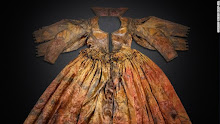I'm sharing another chapter, divided into several parts, from my ongoing and long-in-the-making book...tentatively titled The Spiritual Mission of a Princess. Enjoy!
Fear and Loathing of Women
{Part One}
“Diana appeared at the end of her life as a new and
confident workingwoman with a political agenda,” observed Dr. Colleen Denney in
her study of Princess Diana as a cultural and feminist phenomenon. And
during this same time, as the social and political culture was becoming more
egalitarian, Jungian professor Andrew Samuels wrote that “Diana emerged as a
new kind of leader...she became the visible aspect of long-standing alternative
ideas about leadership, which had been dubbed ‘feminine’ or ‘maternal’.” In his
exploration of Diana’s influence, Samuels considered the “changing of relations
between politicians who lead and citizens who are led is on any thoughtful
contemporary agenda, and the Diana phenomenon may be understood as part of this
move.”
Diana was thrilled when the young Tony Blair and his Labor Party won a landslide victory in May of 1997. “His victory,” wrote Tina Brown, “after eighteen long years of Tory dominance, was welcomed with the euphoria of a new dawn. A young, modernizing, and empathetic Prime Minister and his independent, high-powered wife were pledging to end the corrupt, uptight ways of the crusty old Establishment.” And best of all for the Princess, Blair appreciated and supported her!
Diana was thrilled when the young Tony Blair and his Labor Party won a landslide victory in May of 1997. “His victory,” wrote Tina Brown, “after eighteen long years of Tory dominance, was welcomed with the euphoria of a new dawn. A young, modernizing, and empathetic Prime Minister and his independent, high-powered wife were pledging to end the corrupt, uptight ways of the crusty old Establishment.” And best of all for the Princess, Blair appreciated and supported her!
As a member of the
royal family, Diana had been “well-trained” in keeping a busy work schedule
(the Queen had more work engagements than days of the year.) If Diana had
lived, what kind of “workingwoman” would she have been? Diana was
passionate—and fearless—about her work on behalf of land-mine victims and AIDS
patients and she knew how to use her star power to get media attention for her
causes. Brown wrote in The Diana Chronicles that Tony Blair
told her “he had Diana in mind to boost the Africa initiative on overseas aid
and debt cancellation that became the Millennium Campaign.” Like many modern,
high-profile women who were in leadership positions in business or politics or
working with social-awareness campaigns, Diana was used to being criticized,
even maligned, and held to a different standard. She also knew of the backlash
when a woman stepped on the toes of powerful men or stood up to the patriarchal
establishment. But she was enjoying a high-approval rating with the public and
the press at this time—and she needed that to thrive, because in Diana’s
personal life, as Tina Brown explained, “love, or the lack of it, always
dragged her down.”
Would she have been
willing to risk losing the public’s admiration or the possibility of a stable
love relationship by taking a stand unpopular with her public? What would Diana
have put on the line as scores of working women of her generation did—and like
women of today still do? Like the women, and you may be one of them, who put themselves
in the line of fire just because their “ambition” and ability and intelligence
and vision placed them in an often-edgy position of telling men what to
do.
Writer and teacher
Martha Caldwell wrote about her experience in 2005 attending the first Global
Women’s Leadership Conference sponsored by Zayed University, the women’s
college in Dubai in the United Arab Emirates. She describes a glorious
gathering of 750 women from forty different countries—diverse in their
heritage, background, skills and challenges—most under the age of 25, all aware
of the changing and expanding roles of women and all committed “to lead the
larger world into a new vision.” To open the conference, Caldwell reported, a
short film was shown “in tribute to important female leaders” featuring images
of Indira Ghandi, Eleanor Roosevelt, Hillary Clinton, Mother Teresa, Margaret
Thatcher and others. Then, “near the end of the film an image of Princess Diana
appeared, a photo of her visiting a children’s hospital. Spontaneous applause
erupted throughout the room—the only time during the film this happened.”
For Caldwell, the
moment was a surprise—and a mystery. “Why, after so many years, does Diana’s
legacy continue to evoke such a passionate response?” The rich connections and
shared experiences during this confluence of international women—mothers,
executives, teachers, designers, entrepreneurs—clarified her inquiry when a
“style of leadership that is particularly female began to emerge from the
shared work of the conference.” Martha Caldwell described this vision and what
she discovered because “this very feminine style of leadership” that Diana
encouraged is such a brilliant model for women today:
A
style of leadership…based on a vision of deep care and compassion, a love of
the Earth and her people, a style of leadership that strives to express itself
in the sustainable nurturance of the whole human family. As much as anyone else
in recent history, Diana, with her open spirit, her great personal warmth and
charitable gift to humanity exemplifies this very feminine style of leadership.
It is because of her archetypal role that she continues to be the Princess of
the people.






















